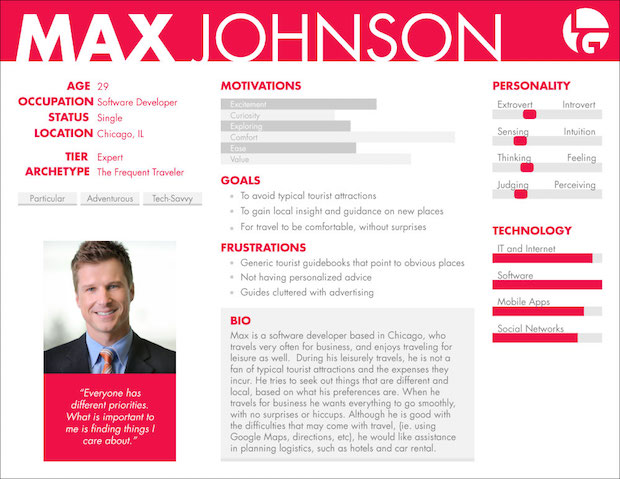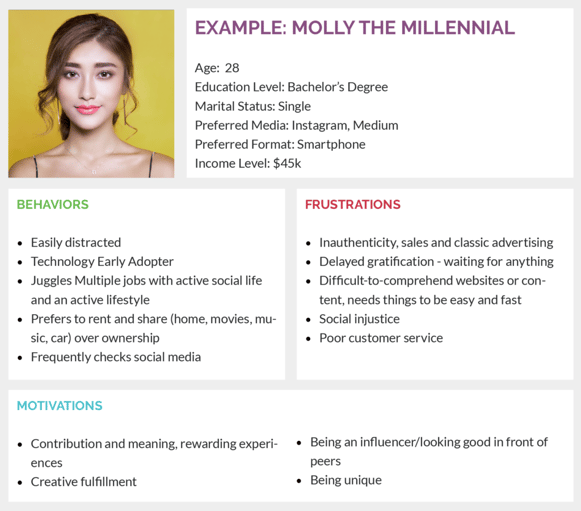Do you talk to your grandma the same way you talk to your best friend? We hope not.
Too many brands focus on what they say and not enough on who they’re saying it to.
Who you are delivering a message to, and how you deliver it, are both crucial to the overall effectiveness of the message.
This is where brand personas come in handy.
What is a Buyer Persona?
Simply put, a buyer persona is a semi-fictional person that your brand identifies as their ideal customer. This persona is built with market research and data you have from existing customers.
A buyer persona has a name, gender, and age- just like a real person.
After identifying the basics of your buyer, you can move into psychographics and give them an education level, profession, personality, pain point, goals and more.
Take this example from OptinMonster; it’s thorough, concise, and realistic. It also gets bonus points for being organized and color coordinated.

Notice the quote in the bottom left hand corner. This is a real quote from one of their customers and is a common addition to many buyer personas.
Buyer quotes are acquired during market research and are valuable tidbits that bring reality to your semi-fictional creation.
A business (or in this case, an organization) can have more than one buyer persona, however, be careful not to create too many. Having too many personas in your sights can make it harder to create consistent messaging, potentially leading to diluted messaging that isn't great for any of your personas.
When you’re done creating your persona(s), send it around to your teammates and let everyone get acquainted with your creation. The more familiar everyone is with the ideal buyer, the easier it is to have consistent marketing.
Why Fundraisers Need Donor Personas
A buyer persona is important for learning about your customers and crafting a marketing strategy to appeal to them.
This creates standards for content and allows your brand to maintain consistency across your communications.
According to Hubspot, buyer personas help you identify your audience's interests, goals, and pain points, which are useful in attracting new leads to your business and converting current leads into customers.
Buyer personas are not just for businesses selling a product.
They can also be useful for fundraisers who are selling an idea or service, like us.
Enter the ‘Donor Persona’, which is similar to a Buyer Persona but with slightly different goals.
A donor persona is essentially a buyer persona, but instead of focusing on selling a product or service, we are selling an idea and a mission.
Donor personas are focused more on motivation, emotions and what drives giving behavior.
A large part of successful fundraising is knowing who is most likely to connect to your mission and how to storytell in a way that encourages your audience to take action. Without knowing who you are talking to, it is hard to know what to ask and how to ask it.
Learning donor personas makes your asks more personal and less like a sales pitch- which is crucial for gaining donor trust and loyalty.
How to create a Donor Persona
To create a donor persona, start by looking at your existing donors first. Do they have any consistencies in age, gender, profession, etc.?
Interview loyal donors and ask them questions pertaining to their personal interest in your mission. Try to discover more about them beyond what you can determine by looking at them. Google Surveys are a great option for surveying your email list, and it’s free!
Classy suggests following every question with “Why?” to better understand potential donors’ goals, behaviors, and what drives them to give.
To take it a step further, we believe that “What, Why, When, Where, and How” questions are crucial when understanding your donors.
Here are some example questions:
-
What convinced you to make a donation?
-
Why are you connected to our mission?
-
When did you decide you wanted to get financially involved with our mission?
-
Where do you interact with our brand the most?
-
How do you determine your level of giving?
These pointed questions help determine the effectiveness of your content in converting leads into donors. If you are looking for more in-depth questions to ask, this resource from Classy is a great place to start.
Although fundraisers aren’t selling a product, they are selling an idea and a cause and are still trying to acquire funds. With that said, buyer personas and donor personas have many overlaps. Here is an example of a donor persona from The Modern Nonprofit:

The main difference between a buyer and donor persona is understanding the motivation behind a donors behavior. Fundraisers are focused less on pain points and more on emotions, which is evident in not only the motivation section of the profile, but also in the application of the data.
Remember that the main goals in creating a donor persona are to better understand your target audience, where they get their information, and how you can reach them.
Once you determine those aspects, you can work on creating content custom fit for your ideal donor and start attracting more of them!
Conclusion
Reaching your audience is difficult when you are not sure who your audience is. When creating a donor persona, begin with your existing donors and extrapolate the details of your ideal donors.
Then you can use this information to create more informed marketing materials that draw and retain your audience.
Who is your ideal buyer or donor? Do they have a name? Tell us in the comments below or on social!


